Abstract
The thermal expansion of francisite, [Cu3BiO2](SeO3)2Cl, a rare copper(II)-bismuth(III) oxide chloride selenite, was studied by high-temperature X-ray powder diffraction over the temperature range 293–773 K. The mineral is stable up to 748 K at which temperature it decomposes to [Bi2O2]Se, CuO and, probably, [BiO][CuSe]. The thermal expansion has an anisotropic character (αa = 9.0, αb = 4.7, αc = 17.0 · 10−6 K−1), which is determined by the distribution of the bonds between additional oxygen atoms (aO) and metal atoms (A). These bonds form two-dimensional systems in which each aO atom is tetrahedrally coordinated by one Bi and three Cu atoms. Thus the structure can be described in terms of oxocentered metal atom tetrahedra consisting of [aO2Cu3Bi] layers of (aOCu3Bi) tetrahedra, (SeO3) groups and Cl anions. This description gives the most reasonable viewpoint to explain the anisotropic thermal expansion character of francisite.
Similar content being viewed by others
Author information
Authors and Affiliations
Additional information
Received: 25 June 1999 / Accepted: 29 October 1999
Rights and permissions
About this article
Cite this article
Nazarchuk, E., Krivovichev, S., Pankratova, O. et al. Thermal expansion of francisite, [Cu3BiO2](SeO3)2Cl, and its interpretation based on oxocentered copper-bismuth tetrahedra. Phys Chem Min 27, 440–444 (2000). https://doi.org/10.1007/s002699900079
Issue Date:
DOI: https://doi.org/10.1007/s002699900079




